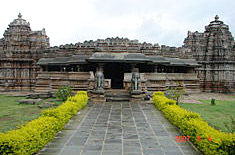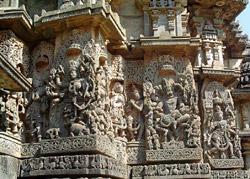Hoysala architecture is the distinctive style of art developed during the dynasty of the Hoysala Empire in the region of today`s Karnataka in south India, between eleventh to fourteenth centuries. Hoysala sculpture reached its pinnacle in the thirteenth century when it dominated the southern Deccan art style. Many large and small temples built during this era represents the architectural and sculptural characteristics, including the Chennakesava Temple at Belur, the Hoysaleswara Temple at Halebidu, and the Kesava Temple at Somanathapura. Other examples of fine Hoysala craftmanship are the temples at Belavadi, Amrithapura, Hosaholalu and Nuggehalli. Study of these temples has revealed Indo-Aryan influence of them but most predominant impact is of Southern Indian styles.
The frequent temple building practice of the Hoysala Empire represents the strong influence of social, cultural and political events of that period. The stylistic art of Karnataka temple building tradition also reflects religious trends, among which most popular schools were Vaishnava and Virashaiva. The growing military prowess of the Hoysala kings compelled them to patronize temple building as they wanted to surpass the artistic achievement of neighbouring Chalukya rulars.The temples built before hoysala independence in the mid-twelfth century exposes significant Western Chalukya influence while temple built in the later phase though retain some of the salient features of Chalukyan art but also adds up some inventive decoration and ornamentation and other features unique to Hoysala artisans. About one hundred examples of Hoysala art have been survived in present day Karnataka state, which are mostly situated in the hilly Malnad district, the native home of Hoysala kings.
These temples as a form of hoysala art not only is a popular tourist destination in Karnataka, but also offer the art students and researchers an excellent opportunity to examine medieval Hindu architecture in the ancient Dravidian style. The tradition began on the seventh century under the disdain of Chalukya dynasty of Badami which flourished further under the Western Chalukyas of Basavakalyan in the eleventh century. Finally the art reached its zenith and transformed into independent style by the twelfth century during the reign of Hoysalas.In the temples there are medieval Kannada language inscriptions which give details of the temples and provide valuable information about the history of hoysala dynasty. Some famous structures of Hoysala art are-
BELUR : This is situated forty kilometers away from Hasan on the bank of the river Yagachi and was the capital of Hoysalas about eight hundred years ago. Many temples and monuments are present in Belur which are the mute witnesses of ancient Hoysala sculpture and architecture.
 VEERANARAYANA TEMPLE : This is located west to the Chenakesava temple on the bank of the river Yagachi and houses some finely sculptured figures of various Hindu gods.
VEERANARAYANA TEMPLE : This is located west to the Chenakesava temple on the bank of the river Yagachi and houses some finely sculptured figures of various Hindu gods.
THE CHENAKESAVA TEMPLE : This temple stands in the courtyard of Belur and is dedicated to Lord Krishna.This temple was built by the Hoysala king Vishnuvardhana in 117 AD and took a century to complete. This supreme architectural beauty is one of the earliest of its type.
The temple built on a star-shaped platform has three doorways and figures of `Madanikas`, which are the masterpieces of Hoysala craftsmanship. The salient features of the temples are subtle carvings on stone walls and the gravity pillars in the courtyard. The interior of the temple is decorated more richly than the outside, which contains many exquisite panels and intricately ornamented pillars. The magnificent sculptures of the temple give a vivid picture. The line of six hundred and fifty elephants carved in different figures surround the base. The young musicians and dancers are inlaid on either side of the main door on a screen. The hand-lathe-turned pillars are ornamented by superb carving.
HALEBID : The Halebid was the wealthy capital city of Hoysala empire earlier  known as Dwarasamudra, situated thirty nine kilometers from Hasan. The Hoysaleswara temple at Halebid is a remarkable example of Hoysala architecture. The temple was built in 1121 AD and it was the largest of the Hoysala temples. The walls of the Hoysaleswara temple are covered with detailed relief and sculptures depicting scenes narrated in Hindu epics.
known as Dwarasamudra, situated thirty nine kilometers from Hasan. The Hoysaleswara temple at Halebid is a remarkable example of Hoysala architecture. The temple was built in 1121 AD and it was the largest of the Hoysala temples. The walls of the Hoysaleswara temple are covered with detailed relief and sculptures depicting scenes narrated in Hindu epics.
The armies of Delhi sultanate destroyed the temple in 1311 and 1327. It was deserted after its attack and later it was renamed as Halebid or Old capital. Fortunately the great Hoysalesvara temple escaped from the Muslim attack. Skilled hands, giving importance to even the minutest details, have carved the sculptures. The temple also contains two massive Monolithic bulls.
The archeological museum located on the Hoysaleswara temple premises contains many sculptures from twelfth to thirteen century, woodcarvings, idols, coins and inscriptions.
There is a twelfth century Jain Bastis in a garden enclosure situated one kilometer south of Halebid, which have glimming blackstone pillars and carved ceilings.
 HOYSALESVARA TEMPLE : This temple is set in the lawns and has two shrines, among which one is dedicated to Santeleswara and other is to Shiva. A nandi bull is placed in front of the shrine. The sculptures inside the temple shows the highest skill of its artisans depicting the various scenes from Ramayana, Mahabharata and old epics like Krishna lifting mount Govardhana, Rama defeating the demon king Ravana. There were 84 female figures in the temple, among which 70 were stolen and the remaining 14 figures are still present in the temple.
HOYSALESVARA TEMPLE : This temple is set in the lawns and has two shrines, among which one is dedicated to Santeleswara and other is to Shiva. A nandi bull is placed in front of the shrine. The sculptures inside the temple shows the highest skill of its artisans depicting the various scenes from Ramayana, Mahabharata and old epics like Krishna lifting mount Govardhana, Rama defeating the demon king Ravana. There were 84 female figures in the temple, among which 70 were stolen and the remaining 14 figures are still present in the temple.
SRAVANABELAGOLA : The place is one of the most sacred place to Jain pilgrims, wedged between two rocky hills-Indragiri and Chandragiri. The colossal statue of Jain saint Gommateshvara, standing atop the Indragiri hills is famous for its huge structure of 17 meters and said to be the tallest and most graceful monolithic statues in the world.
BHANDARI BASTI : This is a spacious sanctuary which houses twenty four statues of Jain Tirthankaras.



















